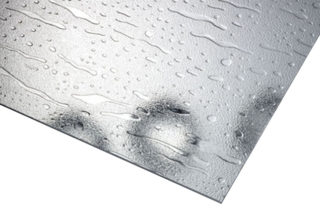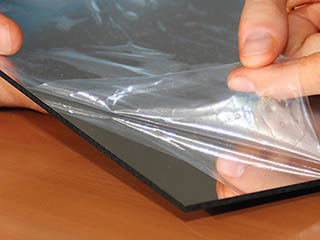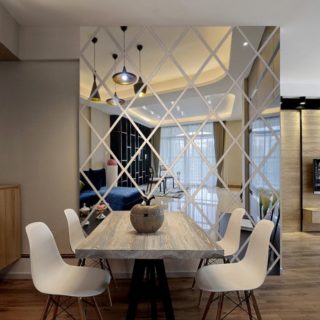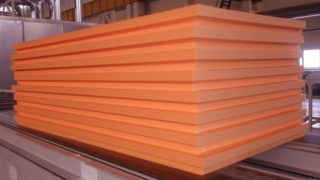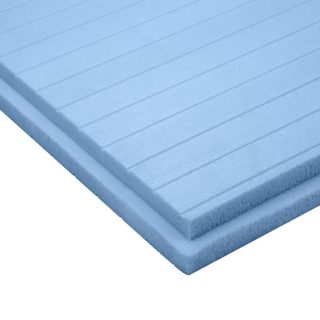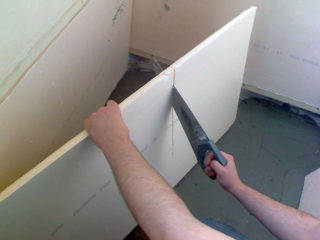The result of the polymerization of styrene monomer is sheet polystyrene, which is available as one of the types of thermoplastic polymers. The material is very practical, as a result of which it has become widespread in several fields of application. Affordable price makes it even more indispensable in comparison with analogues.
Specifications
Due to its properties, polystyrene has taken the position of a quality substitute for glass. Having high light-scattering properties, its scope is very diverse. It can act as glazing in the construction of greenhouses and hotbeds and be used in the manufacture of decorative lighting elements.
In the construction sector, when performing finishing work, the most popular are:
- sheet mirror polystyrene;
- polystyrene with a matte surface;
- polystyrene with a glossy surface.
An explanation of this popularity are the technical characteristics of the material:
- thermoplasticity;
- resistance to chemicals;
- high moisture resistance;
- impact resistance;
- light transmittance;
- machinability compliance;
- increased electrical insulation properties.
The only drawback that spoils the positive picture of perception is the combustibility of the material. But this is not a problem if you take care of fire safety in advance.
Dimensions
The size range of the material is very diverse. You can select a specific size of panels and sheets, which are then easily cut into the necessary blanks.
Most often, a polystyrene sheet can be found in such sizes:
- 1500 x 2400 mm
- 1000 x 1400 mm
- 1000 x 2000 mm
- 2000 x 3000 mm.
Many manufacturers accept orders for the manufacture of material in the sizes specified by the client.
Release Forms
The scope of the material depends on several factors, including the form of release, which differs in the way of production.
- Finished sheets having different lengths, thickness and width, color. Through the use of dyes, colored polystyrene sheets are obtained.
- Foamed polystyrene - polystyrene. Due to its structure, it is very light, which allows it to be used as a heater, without the risk of weighting the structure.
The first type is often used for decorative purposes, the second copes with the task of insulation or packaging.
Physical and chemical properties
Material properties depend on several parameters: molecular weight, production methods, etc. The strength of polystyrene and its softening temperature depends on the molecularity of the granule fractions. The higher this indicator, the lower the strength.
The average properties of polystyrene:
- resistance to bending - 103 MPa;
- thermal conductivity coefficient - 0.16 W / m K;
- material density - 1.05 g / cm3;
- tensile strength - 55 MPa;
- refractive index - 12.59;
- elongation resistance - 3%.
These are general indicators specific to all types of material. They may vary slightly depending on the manufacturing process. You can find out more accurate information by looking at the seller’s product certificates.
Fire hazard properties
The fire resistance index for polystyrene is only 17-19%, it is very small compared to other materials.When ignited, the material does not lose its properties, even if it is part of reinforced concrete. Therefore, fire services always have an increased interest in the construction of houses using such a heater.
Polystyrene cannot ignite spontaneously. This only happens when the material comes in direct contact with fire. If this happens, in addition to the fact of ignition, it must be taken into account that the foam emits toxic gases. Therefore, before using it, you need to weigh the pros and cons.
The flammability of polystyrene encouraged manufacturers to develop new types of material with higher fire safety properties by adding smoke-absorbing components and other additives to the familiar composition.
Types of material
The manufacturing process and other structural characteristics of the material affect the final result. There are several types of polystyrene:
- high impact sheet polystyrene;
- general purpose material;
- extruded polystyrene.
Impact resistant material
The production is based on the polymerization of vinylbenzene with the addition of butadiene rubber. The main positive properties of the material are:
- machinability compliance;
- thermoplasticity;
- environmental friendliness.
The rubber content in the impact-resistant polymer is 10-15%, in the usual, only 4.5%.
Among the shortcomings, a low light transmittance is noted. Basically, this material is presented in the form of black polystyrene with glossy or matte surfaces.
General purpose polystyrene
Externally, ordinary polystyrene is transparent and meets the requirements of GOST 20282-86. It is fragile, but resistant to chemicals, dielectric ability at height.
In the production process, 2 methods are used: suspension and block. Further, the material is extruded into two types of sheet blanks:
- Smooth plasgal, characterized by high light-scattering properties, low strength characteristics, increased resistance to low temperatures. The thickness of the sheets varies from 2 to 6 mm.
- Corrugated plasgal, characterized by an average thickness of polystyrene of 2 mm, the presence of embossments, for refraction and reflection of sunlight, low characteristics of impact resistance.
The latter type of polymer is most often used for decorative interiors.
Extruded polymer
Due to the closed porous structure, the density of the extruded material increases. The process consists in the manufacture of the polymer by heating the granules with their foaming and further converting the material into a sheet or roll form.
Styrofoam and polystyrene foam act as analogues of this type, but they are inferior to extruded polystyrene in terms of light transmission, resistance to aggressive environments, humidity and susceptibility of damage to the fungus.
Scope of application
Many of the positive properties of the polymer could not but affect its popularity. He has held steady positions in several industries:
- construction - during interior decoration and exterior decoration;
- advertising - in the manufacture of plates and signs;
- medicine - in the production of disposable syringes, droppers;
- agriculture - when arranging greenhouses and greenhouses, white polystyrene acts as a substitute for glass;
- food industry - in the manufacture of packaging products;
- manufacture of plumbing - in the process of creating showers and bathtubs;
- typographic sphere - used as the basis for stencils;
- electrical industry - in the manufacture of materials for insulation.
In addition to these areas, there are other areas of use: military industry, mechanical engineering, instrument engineering - where he received no less recognition.
Material benefits
Among the main advantages of sheet material can be identified:
- competitiveness with other types of thermoplastics;
- resistance to chemicals on the surface;
- non-susceptibility to destruction when exposed to alcohol-containing substances and acids;
- susceptibility to mechanical manipulation (drilling, cutting, milling);
- compliance to gluing and heat sealing;
- thermoplasticity;
- resistance to moisture and damage by fungal spores;
- wear resistance;
- high operational ability;
- variability of performance;
- environmental Safety;
- the possibility of processing;
- affordable cost.
With all the pros, do not forget about the cons: low fire resistance, tendency to crack and fragility.
Polystyrene Sheet Processing
High thermoplasticity allows you to use this material for the manufacture of various products used in the domestic and industrial sphere. As a result of this, several types of processing can be distinguished, which can be polystyrene
- sawing with hand and stationary tools;
- drilling with drills for various purposes (for metal or plastic);
- file edge processing with files or a planer;
- thermoforming through the use of high temperatures and vacuum;
- ultrasonic welding or gas welding;
- bonding of several sheets by means of synthetic compositions based on neoprene and cyanoacrylate;
- drawing drawings and texts without preliminary surface preparation;
- varnishing with synthetic and natural compounds;
- polishing the surface with a special wheel and polishing paste;
- milling on special machines;
- application of metal dust in a vacuum.
For processing sheets of shock-resistant material are more suitable.
Softening of polystyrene occurs at a temperature of 95 degrees, so after all types of processing it is necessary to use a liquid to cool the surface.
Polystyrene is a kind of plastic that has gained immense popularity due to its ease of processing, thermoplasticity, resistance to chemical attack and temperature changes. Reasonable price allows you to choose the material according to external data and technical specifications.
